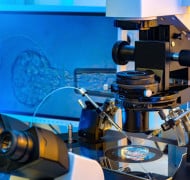Exploring Different Types of Fertility Treatments and Procedures
Posted on July 24th, 2023

Embarking on the journey to parenthood can be both thrilling and challenging. For those facing difficulties conceiving naturally, single aspiring parents, and LGBTQ+ families, the world of fertility treatments opens up a realm of hope and possibilities. These modern medical interventions are designed to turn dreams of having a family into reality. Treatments are uniquely tailored to an individual's medical history, the underlying fertility issue, and various factors that play a pivotal role in shaping the path to parenthood. In this blog post, we'll explore the diverse landscape of fertility treatments and procedures, unveiling the most common and effective options available.
In Vitro Fertilization (IVF)
In vitro fertilization (IVF) is by far the most well-known fertility treatment. During this procedure, eggs are removed from the ovaries and fertilized in a laboratory with sperm. The resulting embryos are then transferred into the recipient’s uterus. In addition to IVF, other techniques may be used, such as intracytoplasmic sperm injection (ICSI), preimplantation genetic testing (PGT), and frozen embryo transfer (FET).
Intrauterine Insemination (IUI)
Intrauterine insemination (IUI), also known as artificial insemination, is a fertility procedure that increases the chance of the sperm reaching the egg by introducing sperm directly into the uterus during ovulation. IUI can improve the likelihood of conceiving in several ways, including:
- Decreasing the time it takes for the sperm to travel and reach the egg
- Introducing larger numbers of sperm, which creates a greater likelihood of the sperm reaching the fallopian tubes to fertilize the egg
- Synchronizing the timing of the sperm and egg to come together for fertilization
Fertility Preservation
Fertility preservation, also referred to as cryopreservation, allows people to preserve their eggs or sperm for future use. Both egg freezing and sperm freezing may be recommended for people who want to safeguard their future fertility potential, whether for personal reasons or medical ones. Patients also have the option of freezing embryos that have been created via IVF so that they can be used as part of a future IVF cycle.
Oncofertility is an offshoot of fertility preservation that is specifically available to patients who are about to undergo treatment for cancer. Many of the life-saving therapies for cancer, including chemotherapy and radiation, can harm the reproductive system, making it difficult to have a child later in life. Oncofertility gives cancer patients the chance to preserve their eggs, sperm, or embryos beforehand, thus providing some peace of mind while they focus on their health.
Third-Party Reproduction
Third-party reproduction refers to a subset of fertility treatments involving a third party to achieve pregnancy. The most common types include sperm donation, egg donation, and gestational surrogacy. These types of assisted reproduction technologies are used to help a wide variety of patients, including those with fertility issues, LGBTQ+ families, and aspiring single parents.
Egg and sperm donation both involve using genetic materials donated by other people; with egg donation, eggs are retrieved from the donor’s ovaries, fertilized with sperm, and transferred to the recipient’s uterus via IVF; with sperm donation, donated sperm can be used as part of an IUI or IVF cycle. Meanwhile, gestational surrogacy involves working with a gestational carrier, which is a person who carries a pregnancy and delivers a baby for a family that cannot carry a pregnancy to term.
Advanced Fertility Care in Texas
The best type of fertility treatment varies from person to person depending on several factors. If you are considering fertility treatment, the first step is to undergo a thorough fertility evaluation by a fertility specialist to determine the most effective treatment plan for you. To learn more about your fertility care options in Texas, contact Aspire Fertility today.

























